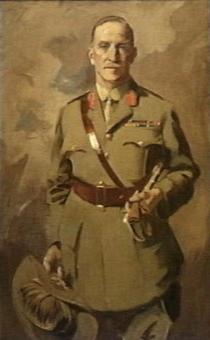
Back هاري شوفيل Arabic هارى شوفيل ARZ Harry Chauvel Danish Harry Chauvel German Henry Chauvel Finnish Harry Chauvel French הנרי שובל HE Harry Chauvel Portuguese Harry Chauvel Turkish
Sir Harry Chauvel | |
|---|---|
 Lieutenant General Sir Harry Chauvel 1919 portrait by James Peter Quinn (1870–1951) | |
| Born | 16 April 1865 Tabulam, New South Wales |
| Died | 4 March 1945 (aged 79) Melbourne, Victoria |
| Buried | |
| Allegiance | Queensland Australia |
| Service | Queensland Defence Force Australian Army |
| Years of service | 1884–1930 1940–1945 |
| Rank | General |
| Commands | Volunteer Defence Corps (1940–45) Chief of the General Staff (1923–30) Desert Mounted Corps (1917–19) Desert Column (1917) Anzac Mounted Division (1916) 1st Division (1915–16) New Zealand and Australian Division (1915) 1st Light Horse Brigade (1914–15) |
| Battles / wars | |
| Awards | Knight Grand Cross of the Order of St Michael and St George Knight Commander of the Order of the Bath Mentioned in dispatches (11) Grand Officer of the Order of the Nile (Egypt) Croix de guerre (France) |
General Sir Henry George Chauvel, GCMG, KCB (16 April 1865 – 4 March 1945) was a senior officer of the Australian Imperial Force who fought at Gallipoli and during the Sinai and Palestine Campaign in the Middle Eastern theatre of World War I. He was the first Australian to attain the rank of lieutenant general and later general, and the first to lead a corps. As commander of the Desert Mounted Corps, he was responsible for one of the most decisive victories and fastest pursuits in military history.
The son of a grazier, Chauvel was commissioned as a second lieutenant in the Upper Clarence Light Horse, a unit organised by his father, in 1886. After the family moved to Queensland he was commissioned as a second lieutenant in the Queensland Mounted Infantry in 1890, and saw service during the 1891 Australian shearers' strike. He became a regular officer in 1896, and went to the United Kingdom as part of the Queensland contingent for the 1897 Diamond Jubilee of Queen Victoria. In 1899 he commanded one of two companies of Queensland Mounted Infantry that were Queensland's initial contribution to the Boer War. After the war, he was closely involved with the training of the Australian Light Horse.
Promoted to colonel in 1913, Chauvel became the Australian representative on the Imperial General Staff but the First World War broke out while he was still en route to the United Kingdom. Chauvel arranged for the Australian Imperial Force to be diverted to Egypt, where he joined his new command, the 1st Light Horse Brigade, in December. In May 1915, it was sent dismounted to Gallipoli, where Chauvel assumed responsibility for some of the most dangerous parts of the line. He took charge of the 1st Division that November. In March 1916, Chauvel became commander of the Anzac Mounted Division, gaining victories in the Battle of Romani in August and the Battle of Magdhaba in December, and nearly winning the First Battle of Gaza in March 1917. The following month, he took over the Desert Column, later known as the Desert Mounted Corps, thereby becoming the first Australian to command a corps, and the first to reach the rank of lieutenant general. At Beersheba in October 1917, his light horse captured the town and its vital water supply in one of history's last great cavalry charges. By September 1918, Chauvel was able to effect a secret redeployment of three of his mounted divisions and launch a surprise attack on the enemy that won the Battle of Megiddo. He followed up this victory with one of the fastest pursuits in military history.
In 1919, Chauvel was appointed Inspector General, the Army's most senior post. He was forced to maintain an increasingly hollow structure by politicians intent on cutting expenditure. He was concurrently Chief of the General Staff from 1923 until his retirement in 1930. In November 1929, he became the first Australian to be promoted to the rank of general. During the Second World War, he was recalled to duty as Inspector in Chief of the Volunteer Defence Corps.